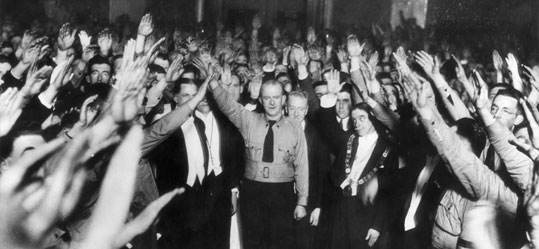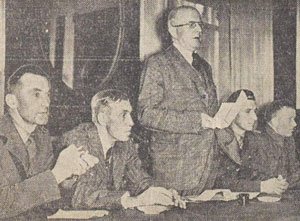By Jack Traynor
Widely regarded as Ireland’s foremost fascist leader, public awareness of Eoin O’Duffy’s career generally hinges on his leadership of the Blueshirts (1933–5) and his involvement in the Spanish Civil War as head of the Irish Brigade (1936–7). His activities during the Emergency (1939–45) have largely been overlooked, with the exception of a claim that he made a bombastic offer to Nazi Germany to organise a volunteer ‘Green Division’. It was suggested that this force would fight alongside the Wehrmacht against the Soviet Red Army in the inhospitable conditions of the Eastern Front. The reputed offer has occasionally been mentioned in Irish historiography to illustrate O’Duffy’s dwindling grasp of reality and his pro-Nazi proclivities. Enno Stephan wrote that the offer was ‘not taken seriously’. O’Duffy’s biographer, Fearghal McGarry, argued that the incident was more likely ‘the product of alcohol or self-delusion than any real intent’. What was the origin of this claim and did it have any substance?

PRO-AXIS UNDERGROUND
The outbreak of the Second World War in September 1939 prompted the de Valera-led Irish government to immediately adopt a policy of strict neutrality, which became gradually more pro-Allies as the war progressed. Despite widespread Irish support for neutrality, including publicly from O’Duffy, a pro-Axis underground operated in Dublin. In February 1940 the pro-Nazi ‘Irish Friends of Germany’ (IFG) was formally founded at a secret meeting in O’Duffy’s Mount Merrion home. Attendees included his secretary and a former key organiser of his defunct National Corporate Party, Liam Walsh; Séamus Hann, a County Wicklow businessman of German extraction whom G2 believed to be ‘the brains of the operation’; John A. Holden, a journalist attached to the Irish Press; and Dr Patrick McCartan, a senior Sinn Féin emissary during the War of Independence and a former pro-Treaty TD.

Although he played host to the inaugural meeting of the IFG, O’Duffy tried to keep his distance from pro-Axis circles, which he suspected were being monitored. Following the June 1940 internment of fifteen IFG members, including his indiscreet secretary, O’Duffy’s heightened fear of arrest led him to largely withdraw from clandestine collaborationism. Although he maintained some low-level contact with the German legation in Dublin and had at least one meeting with the German spy Hermann Görtz, O’Duffy’s final years were spent as president of the apolitical National Athletic and Cycling Association (NACA). He also unsuccessfully lobbied the Fianna Fáil government for a State appointment, either as head of the Irish Red Cross or as Chief Local Security Officer.
Whilst O’Duffy largely absented himself from active collaboration during the war years, the German Abwehr continued to see Ireland as strategically important. In their quest for would-be collaborators, they found a mixed bag of fair-weather friends and ideological Nazis. In May 1940 Hermann Görtz parachuted into Ireland with instructions to contact the IRA. He remained on the run for nineteen months, during which time he mingled with the seedier elements of Ireland’s pro-Axis underground. By 1941 he had crossed paths with Joseph Andrews, a Dublin jeweller with an IRA background who had tried in vain to secure a commission in the Defence Forces. He was associated with the People’s National Party, a ‘stillborn organisation’ founded by an ex-IFG member which espoused an anti-Semitic and pro-Nazi world-view. Andrews typified the sort of unscrupulous individual involved in pro-Axis activism in wartime Ireland. MI5 believed that Andrews, described as a ‘shady customer’, was principally interested in selling the Germans information about the sweepstake organisation in America. He and his wife, Norah O’Sullivan, enjoyed a ‘rather high lifestyle’ and lived beyond their means, which led MI5 to conclude that they would ‘probably undertake any activity with a view to obtaining money’.
ANDREWS’S TRANSMISSIONS

In September 1941 Görtz and his radio operator, ex-post office technician Anthony Deery, struggled to find shelter in Dublin. Desperate circumstances led them to stay temporarily with a ‘shady friend’ of Joseph Andrews. Görtz’s clique of Irish collaborators had a low opinion of Andrews because of his ‘known character’. To the chagrin of several of Görtz’s friends, Andrews and his wife successfully gained the German spy’s complete confidence. One member of the group walked away in opposition to Andrews’s having wheedled his way into Görtz’s inner circle. When the German spy suggested that the only other person who knew his secret transmission code was a woman, MI5 believed that this referred to Andrews’s wife, whom they considered ‘if anything more unscrupulous and able than the husband’.
In November 1941 Görtz and IRA chief-of-staff Pearse Kelly were arrested. The Nazi agent was interned in Mountjoy prison. Days before the arrest, Andrews had been picked up by the Gardaí but was released shortly afterwards. This raised the suspicions of the German minister in Ireland, Eduard Hempel, who believed that Andrews had informed on Görtz. MI5 also stated that Andrews had double-crossed Görtz by offering information on the German spy to the American minister in Dublin for a fee. Months after the arrests, Andrews tried to establish communications with the Abwehr in Berlin using Görtz’s secret code. On 10 April 1942 a ciphered transmission was sent to Berlin. In it, Andrews identified himself and claimed to have connections with the IRA. He further offered to organise ‘circles’ in the Defence Forces among irredentist officers by tapping into O’Duffy’s contacts. The Germans had been interested in connecting with corrupt elements in the Defence Forces, particularly the pro-Axis sympathiser Hugo MacNeill. Andrews asked to be flown to Germany to further discuss the plans and suggested Malahide as a ‘perfect landing ground’. Following a protracted decoding process and internal exchanges between the Abwehr and the German legation in Dublin, Andrews’s dishonest background was illuminated. Berlin opted not to reply to the communication.
In February 1943 the Abwehr received a new transmission from Andrews, sent care of a ‘Mr Eastwood’, a cook aboard the Irish freighter Edenvale in Lisbon. It explained that Andrews had sent 29 transmissions which went unanswered and again he requested to be collected for a ‘discussion’ with the Abwehr. British intelligence, having intercepted the communications, doubted that Andrews had ‘any organisation’ and believed that he was on a solo run. The German foreign office’s special adviser on Ireland, Dr Edmund Veesenmayer, doubted whether a reply was even worthwhile.
‘GREEN DIVISION’

In March 1943 the Germans received a further transmission from the Edenvale, using Görtz’s code, which claimed that Andrews had ‘consulted General O’Duffy’, who ‘would like to organise a Green Division from Éire to fight against Bolschevism [sic] if you approve’. He requested transport for himself and a ‘representative from O’Duffy’ to discuss the plans in Germany. He also claimed to have devised a jailbreak plan for Görtz. Inexplicably, given their previous scepticism of Andrews and his transmissions, the Abwehr apparently believed that the proposal was genuine. A year after his first outreach, Andrews finally received a reply, enquiring whether the Green Division could be realised and a request for a full report.
In Berlin, Veesenmayer scrambled to formulate a plan on how best to utilise the proposed Irish force. Whilst he realised the impossibility of organising and transporting pro-Nazi Irishmen to the Eastern Front, he tried to solve the conundrum of how to exploit the potential propaganda value from the ‘Green Division’ without incurring the ire of the neutral Irish government.
The Germans showed considerable credulity in responding positively to Andrews’s transmission. Whilst not discounting the slim possibility of O’Duffy’s involvement owing to his tendency to make ‘flamboyant and wild statements’, MI5 was aware that his health was very poor. O’Duffy spent a considerable portion of 1942 in nursing homes and was said to be physically ‘old and broken, but not necessarily mentally so’. The British intelligence report continued, ‘he has displayed no recent interest in politics and his only interest is the Athletic Association’. His only recent Axis link was a monetary donation that the NACA received from Hempel. MI5 therefore doubted that Andrews’s claims were truthful and speculated that his real intention was ‘to extract a lump sum from the Germans’.
The Green Division proposal (presumably Ireland’s answer to the Spanish Blue Division, which participated in Operation Barbarossa) was made by Andrews without O’Duffy’s knowledge or imprimatur. Significantly, it was made after the Battle of Stalingrad, the turning-point in the war, which added a stronger element of farce to the offer. No evidence exists linking Andrews to O’Duffy. In all likelihood, Andrews’s transmission was a desperate effort to grab the attention of the Germans after a year of unreciprocated communications. His desperation was motivated by his declining financial situation (he sold his home in 1942 owing to mounting debts). According to MI5, the outlandish proposal illustrated his ‘neck’.
Andrews netted £100 from the Germans before he was arrested in December 1943. Gardaí found large sums of cash in his house and an unsent typewritten letter hidden in the chimney, intended for Eastwood to transmit to Berlin via Lisbon. This clearly implicated Andrews in a collaborationist scheme. Following Andrews’s arrest, Hempel advised Berlin not to have any further dealings with the suspected charlatan. As the war progressed, Hempel repeatedly pleaded with the Abwehr to halt its sabotage plots and espionage efforts in Ireland, which simply raised the hackles of the Fianna Fáil government. The German minister sagaciously urged Berlin not to undermine Ireland’s neutrality.
O’Duffy was most likely oblivious to the extraordinary proposals made in his name by Andrews. His experience of the Spanish Civil War had soured his taste for foreign adventure, whilst his poor health made the scheme totally unrealistic. Although he had a sneaking regard for Hitler and maintained loose links with pro-Axis activists, O’Duffy’s attitude towards Nazism has been somewhat mischaracterised. For example, a 1939 speech often attributed to O’Duffy, which claimed that ‘yesterday it was Mussolini and Fascism, today it is Hitler and Nazism’, was in fact delivered by Liam Walsh, according to a contemporary Garda report. O’Duffy’s enthusiasm for fascism in the 1930s was mostly for its Italian variant.
O’Duffy’s last public ambition was to see the construction of a national stadium in Dublin, a project he championed in the press. His final years were spent in the leafy suburb of Mount Merrion, answering correspondence, tending to his garden and delivering occasional radio broadcasts on athletics. He died in Pembroke Nursing Home in November 1944, a far more peaceful setting than the scorched earth of war-torn Eastern Europe. Although O’Duffy never proposed the ‘Green Division’, even contemporary intelligence reports acknowledged that it was the sort of ‘wild statement’ to which the quixotic general was prone.
Jack Traynor is an Irish Research Council-funded Ph.D candidate at the Department of History, Trinity College, Dublin.
Further reading
C.J. Carter, The shamrock and the swastika: German espionage in Ireland in World War II (Palo Alto, 1977).
J.P. Duggan, Neutral Ireland and the Third Reich (Dublin, 1989).
F. McGarry, Eoin O’Duffy: a self-made hero (Oxford, 2005).
J. Traynor, General Eoin O’Duffy: the political life of an Irish firebrand (Jefferson, NC, 2024).
